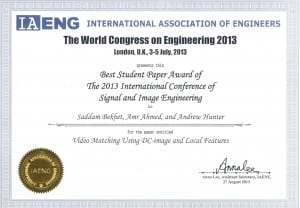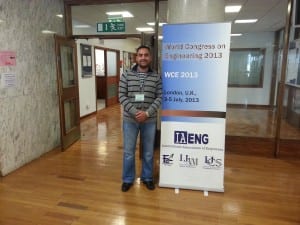The conference paper entitled “Video Matching Using DC-image and Local Features ” presented earlier
in “World Congress on Engineering 2013“ got “Best Student Paper Award 2013”
well done and congratulations to Saddam Bekhet .
New Conference paper presented in the“ World Congress on Engineering 2013”
Saddam Bekhet presented his accepted paper in “World Congress on Engineering 2013“.
The paper title is “Video Matching Using DC-image and Local Features ”
Abstract:
This paper presents a suggested framework for video matching based on local features extracted from the DC-image of MPEG compressed videos, without decompression. The relevant arguments and supporting evidences are discussed for developing video similarity techniques that works directly on compressed videos, without decompression, and especially utilising small size images. Two experiments are carried to support the above. The first is comparing between the DC-image and I-frame, in terms of matching performance and the corresponding computation complexity. The second experiment compares between using local features and global features in video matching, especially in the compressed domain and with the small size images. The results confirmed that the use of DC-image, despite its highly reduced size, is promising as it produces at least similar (if not better) matching precision, compared to the full I-frame. Also, using SIFT, as a local feature, outperforms precision of most of the standard global features. On the other hand, its computation complexity is relatively higher, but it is still within the real-time margin. There are also various optimisations that can be done to improve this computation complexity.
Well done and congratulations to Saddam Bekhet .
PGRs Research Presentations – July 2013
The May’s PGRs Research Presentations was held on Wed. 10th July, 2pm, Meeting Room, MC3108 (3rd floor).
This session we had the following presentations:
| Title: “Using anisotropic spatiotemporal smoothing to reduce blurring in images under low light conditions“. | Title: “Automated Robot Control with Behaviour Selection, Object Classification and Background Subtraction” | |
|
By: Gabriel Zahi |
By: Daniel Pashley & Sean Walton |
|
| Abstract:Improving images in low light involves the process of summing neighbouring pixels locally in space and time to improve the reliability of the intensity of each pixel and to reduced the effect of noise acquired when capturing images under low light conditions. The summation process is stronger among neighbourhood pixels closer to the central pixel and reduces as the pixels are further away from the central pixel. Though the summation process is an effective way of improving the reliability of low light images, it has an adverse effect of blurring the image. This presentation introduces the use of the gradient as an anisotropic method to reduce the noise in the images as well as reducing the blurring caused by the summation method. Using the gradient in the three dimension (x,y,t), we can channel the summation process to lean more towards homogenous pixels and less along non-homogenous pixels. This new approach has proven to reduce the blurring while preserving structures and details.. | Abstract: Our research aims to try and tackle some common risks and issues in traditional search and rescue methods by providing an alternative method by which search and rescue can be carried out. We show how automated ground and air based robots can be used to reduce risk and cost but in turn increase speed of searching. To do this, cost differences between current search and rescue methods and commercial robotic platforms that can be used in place of traditional methods are shown. Along with this, we present how search methods can be improved by replacing one or two helicopters with forty ground and air robots laid out in an efficient pattern that allows the fastest search method. We also show how we can utilise these robots through a central system and use all images and data provided by each of the connected robots to perform background removal and face detection, then use the data in a finite state machine based control system to send control commands back to the robots. Finally, we present a series of experiments along with their results to prove the validity of this solution. | |
Additional presentation by Oliver Szymanezyk , titled:
“Brief on the Masters Prizes and his experience of the event”
The Q/A was followed by a brief cath-up meeting.
EMESP Masters Prize 2013
On Thursday, 19th June 2013, Olivier Szymanezyk, a PhD games computing student at the Lincoln School of Computer Science travelled to Leicester to represent the University of Lincoln at the East Midlands Engineering and Science Professionals (EMESP) Masters Prize.
As described on their homepage, the EMESP provides a voice for the engineering and science profession in the East Midlands. It aims to make people aware and appreciative of the contributions of engineering and science to the economy, prosperity and quality of life. The yearly EMESP Masters Prize aims to link research with industry, allowing prosperous candidates to show their research, ideas and innovations in front of a well-chosen panel of industry experts and academics.
Upon his arrival, Olivier was warmly welcomed by the EMESP Chairman, Ian Treacy, who introduced him to other Masters Prize University representatives. This was shortly followed by a twenty minute presentation of each candidate of their ongoing work. Presentations were most interesting and included talks about blood clotting countermeasures, climate change dwelling adaptations, big data visualisations and novel approaches to the control of quad-rotor helicopters. Olivier talked about his games computing related work on the verification and validation process of simulated crowds for serious applications and video-game environments.
“It was most honourable to have been appointed by a panel of University of Lincoln academics as the representative of the University of Lincoln for the EMESP Masters Prize Event”, says Olivier, “This was a fantastic opportunity to show my work – I highly enjoy talking about my interdisciplinary crowd simulation research, and this was a great opportunity to do so. Furthermore, this was a most well organised event to see research presentations from other EMESP Masters Prize candidates from a wide array of research fields.”
Olivier was awarded the prize as the University’s representative, for his project and presentation, which, in the view of the EMESP Masters Prize 2013 judges and the evidence of its content, was of a high standard and has the potential to make commercial impact. Pictures of the award can be seen below – more pictures of the event will follow shortly.
New Conference paper Accepted to the “ World Congress on Engineering 2013”
New Conference paper accepted for publishing in “World Congress on Engineering 2013“.
The paper title is “Video Matching Using DC-image and Local Features ”
Abstract:
This paper presents a suggested framework for video matching based on local features extracted from the DC-image of MPEG compressed videos, without decompression. The relevant arguments and supporting evidences are discussed for developing video similarity techniques that works directly on compressed videos, without decompression, and especially utilising small size images. Two experiments are carried to support the above. The first is comparing between the DC-image and I-frame, in terms of matching performance and the corresponding computation complexity. The second experiment compares between using local features and global features in video matching, especially in the compressed domain and with the small size images. The results confirmed that the use of DC-image, despite its highly reduced size, is promising as it produces at least similar (if not better) matching precision, compared to the full I-frame. Also, using SIFT, as a local feature, outperforms precision of most of the standard global features. On the other hand, its computation complexity is relatively higher, but it is still within the real-time margin. There are also various optimisations that can be done to improve this computation complexity.
Well done and congratulations to Saddam Bekhet .


